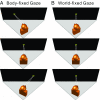Flexible egocentric and allocentric representations of heading signals in parietal cortex
- PMID: 29555744
- PMCID: PMC5889634
- DOI: 10.1073/pnas.1715625115
Flexible egocentric and allocentric representations of heading signals in parietal cortex
Abstract
By systematically manipulating head position relative to the body and eye position relative to the head, previous studies have shown that vestibular tuning curves of neurons in the ventral intraparietal (VIP) area remain invariant when expressed in body-/world-centered coordinates. However, body orientation relative to the world was not manipulated; thus, an egocentric, body-centered representation could not be distinguished from an allocentric, world-centered reference frame. We manipulated the orientation of the body relative to the world such that we could distinguish whether vestibular heading signals in VIP are organized in body- or world-centered reference frames. We found a hybrid representation, depending on gaze direction. When gaze remained fixed relative to the body, the vestibular heading tuning of VIP neurons shifted systematically with body orientation, indicating an egocentric, body-centered reference frame. In contrast, when gaze remained fixed relative to the world, this representation changed to be intermediate between body- and world-centered. We conclude that the neural representation of heading in posterior parietal cortex is flexible, depending on gaze and possibly attentional demands.
Keywords: body/world-centered; egocentric/allocentric; reference frame; ventral intraparietal area; vestibular.
Conflict of interest statement
The authors declare no conflict of interest.
Figures






Similar articles
-
Eye-centered representation of optic flow tuning in the ventral intraparietal area.J Neurosci. 2013 Nov 20;33(47):18574-82. doi: 10.1523/JNEUROSCI.2837-13.2013. J Neurosci. 2013. PMID: 24259579 Free PMC article.
-
Diverse spatial reference frames of vestibular signals in parietal cortex.Neuron. 2013 Dec 4;80(5):1310-21. doi: 10.1016/j.neuron.2013.09.006. Epub 2013 Nov 14. Neuron. 2013. PMID: 24239126 Free PMC article.
-
Heading Tuning in Macaque Area V6.J Neurosci. 2015 Dec 16;35(50):16303-14. doi: 10.1523/JNEUROSCI.2903-15.2015. J Neurosci. 2015. PMID: 26674858 Free PMC article.
-
How Optic Flow and Inertial Cues Improve Motion Perception.Cold Spring Harb Symp Quant Biol. 2014;79:141-8. doi: 10.1101/sqb.2014.79.024638. Cold Spring Harb Symp Quant Biol. 2014. PMID: 26092884 Review.
-
The operation of the visual system in relation to action.Curr Biol. 2012 Sep 25;22(18):R811-7. doi: 10.1016/j.cub.2012.06.049. Curr Biol. 2012. PMID: 23017999 Review.
Cited by
-
The Visuospatial and Sensorimotor Functions of Posterior Parietal Cortex in Drawing Tasks: A Review.Front Aging Neurosci. 2021 Oct 14;13:717002. doi: 10.3389/fnagi.2021.717002. eCollection 2021. Front Aging Neurosci. 2021. PMID: 34720989 Free PMC article.
-
Dynamic spatial coding in parietal cortex mediates tactile-motor transformation.Nat Commun. 2023 Jul 27;14(1):4532. doi: 10.1038/s41467-023-39959-4. Nat Commun. 2023. PMID: 37500625 Free PMC article.
-
A Causal Role of Area hMST for Self-Motion Perception in Humans.Cereb Cortex Commun. 2020 Jul 30;1(1):tgaa042. doi: 10.1093/texcom/tgaa042. eCollection 2020. Cereb Cortex Commun. 2020. PMID: 34296111 Free PMC article.
-
Temporal and spatial properties of vestibular signals for perception of self-motion.Front Neurol. 2023 Sep 13;14:1266513. doi: 10.3389/fneur.2023.1266513. eCollection 2023. Front Neurol. 2023. PMID: 37780704 Free PMC article. Review.
-
Shared neural underpinnings of multisensory integration and trial-by-trial perceptual recalibration in humans.Elife. 2019 Jun 27;8:e47001. doi: 10.7554/eLife.47001. Elife. 2019. PMID: 31246172 Free PMC article.
References
Publication types
MeSH terms
Grants and funding
LinkOut - more resources
Full Text Sources
Other Literature Sources

